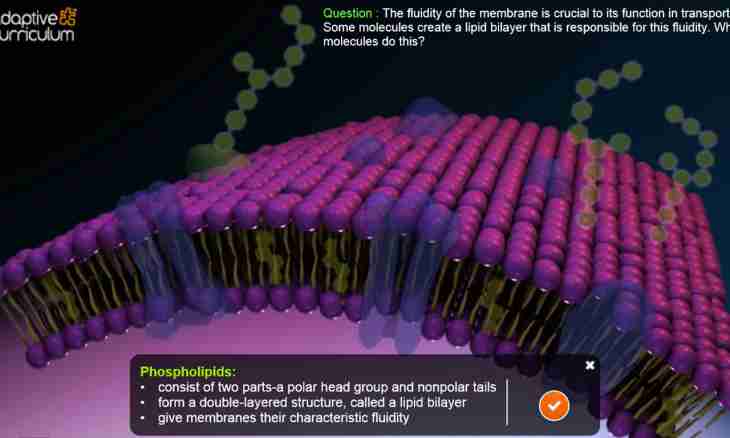Difficult internal cell structure depends on the functions which are carried out by it in an organism. However the principles of creation of all cages are identical. So, any living cell is outside covered plasmatic, or cytoplasmatic, with a membrane.
Structure of a plasmatic membrane
The cytoplasmatic membrane has thickness of 8-12 nanometers therefore it is impossible to consider it in a light microscope. The structure of a membrane is studied by means of an electronic microscope.
The plasmatic membrane is formed by two layers of lipids – a bilipidny layer, or bisloy. Each molecule of a lipid consists of a hydrophilic head and a hydrophobic tail, and in biological membranes the lipids are located heads outside, tails inside.
Numerous molecules of proteins are shipped in a bilipidny layer. Some of them are on a membrane surface (external or internal), others penetrate a membrane through.
Functions of a plasmatic membrane
The membrane protects cage contents from damages, keeps cage shape, selectively passes necessary substances in a cage and removes exchange products and also provides communication of cages among themselves. Barrier, otgranichitelny function of a membrane is provided by a double layer of lipids. It does not allow contents of a cage to spread, mix up with the environment or intercellular liquid, and interferes with penetration into a cell of dangerous substances. A number of the major functions of a cytoplasmatic membrane is carried out at the expense of the proteins shipped in it. By means of proteins receptors the cage can perceive various irritations on the surface. Transport proteins form the thinnest canals across which in a cage and from it there pass ions of potassium, calcium, sodium and other ions of small diameter. Proteins-enzymes provide processes of activity in the cage. The large food particles not capable to pass through thin membrane channels get in a cage by a fagotsitoz or a pinotsitoz. The general name to these processes – endotsitoz.
As occurs endotsitoz – penetration of large food particles into a cage
The food particle adjoins to an external cell membrane, and in this place the emboly is formed. Then the particle surrounded with a membrane gets in a cage, is formed digestive vacuoles, and in the formed bubble digestive enzymes get.
The blood leukocytes capable to take and digest alien bacteria are called phagocytes.
In case of a pinotsitoz the emboly of a membrane takes not firm particles, but liquid droplets with the substances dissolved in it. This mechanism is one of the main ways of penetration of substances into a cage.
The cages of plants covered atop membranes with a firm layer of a cellular wall are not capable to a fagotsitoz.
Process, the return to an endotsitoz, – ekzotsitoz. The substances synthesized in a cage (for example, hormones) are packed into membrane bubbles, approach a membrane, are built in it, and contents of a bubble are thrown out of a cage. Thus the cage can get rid also of unnecessary products of exchange.

